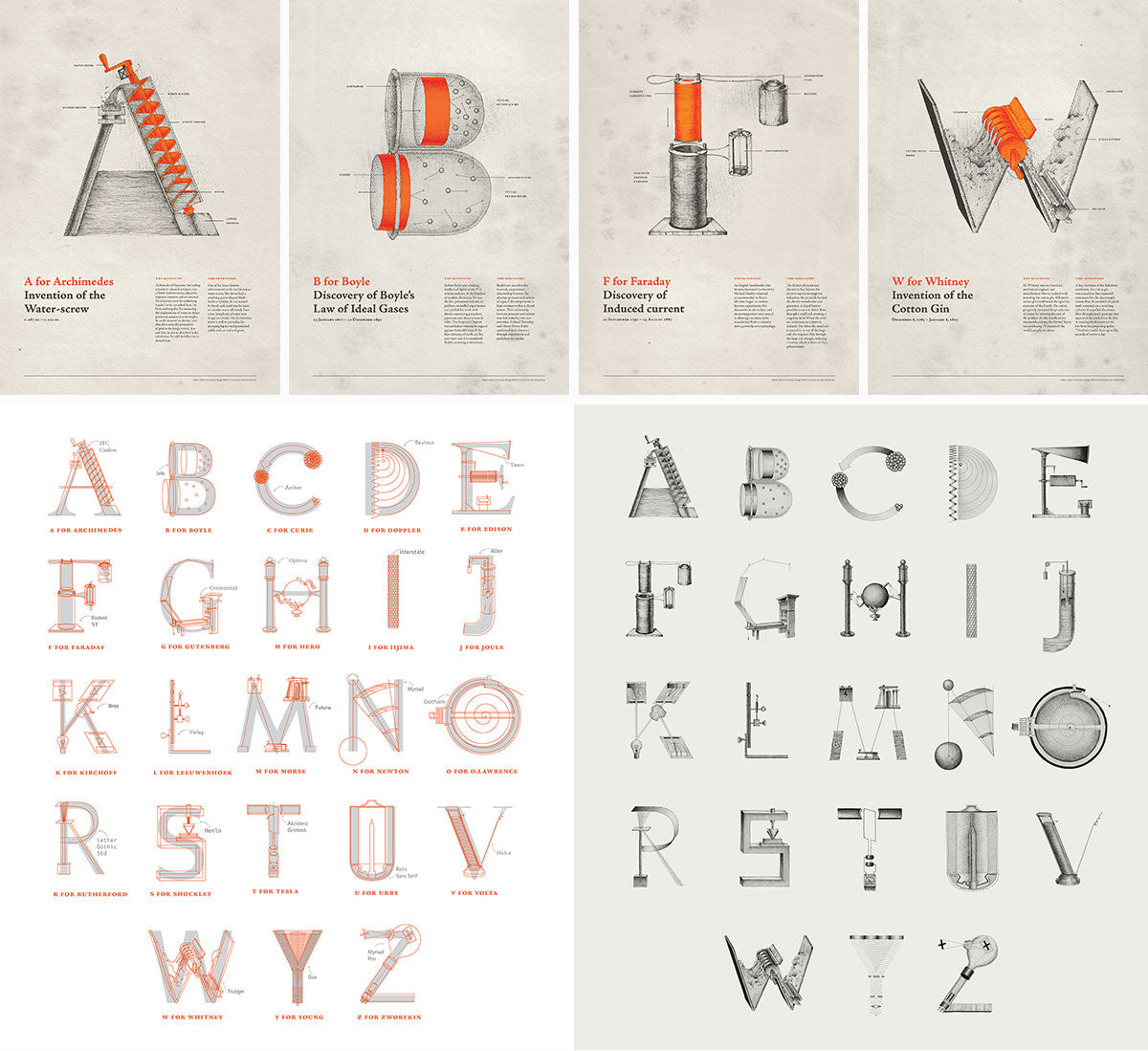Your Cart is Empty

Khyati: I’ve enjoyed art for as long as I can remember. In my school, Mirambika, we had a beautiful art room with the most fascinating stationery cupboard filled with paints, beads, brushes and whatnot. Staring at it for hours was one of my favourite hobbies. I found out about NID from a very friendly senior at Mirambika, Apurba Pawar who was studying product design there at the time. I applied and got lucky! NID lays a lot of emphasis on building skills and 4 years of design education literally sharpened my senses.

Khyati: For my second classroom Project at NID, I worked on 'The Beauty of Scientific Diagrams', a series of alphabets & posters that merged initials of inventors/discoverers with the diagrams that they were responsible for. I spent more time in the company of patent drawings and scientific text books than I did stippling 23 out of 26 illustrative letters. The most challenging part of the project was figuring out how to distort the diagrams to fit the respective letter such that it wasn't rendered useless, so that if a physical model was made in front of you, it would work as efficiently as the original diagram. This meant a lot of studying was going to be involved, which I didn't mind at all.

Each of These Illustrated Letters Depicts a Brekthrough Invention - Featured inWired, 2014
Being invited to intern at the Think Tank Team in San Jose, California for my thesis project was surreal, as it's led by Pranav Mistry, the person I remember studying thoroughly when he was the theme for our class board in my 11th Grade. I got thrown into the whizzing technology-driven and alien world of Silicon Valley for 5 months & felt small working amidst brilliant product designers, engineers and researchers. Interning at the Indian Type Foundry under Satya Rajpurohit & designing Tarsus was the steepest graph of learning I've experienced so far. I came out of it being a completely different designer.

Working at Codesign for over a year was the whole package: hard work, fun & a lot of learning under the greats.
36 Days of Type is a project that invites Designers to express their view on letters and numbers of our alphabet. I decided to flex my Photo Manipulation muscles to distort common objects. I ended up learning a lot about light and shadow as I'd draw the shadows with a basic Photoshop brush. The illustrations had to be done on a daily basis for a duration of 36 days. This routine aspect of the project was really thrilling! After a point, I used to just wait for 9PM for the idea to come to my head and get on it.

36 Days of Type Grid
Khyati: I work mostly in the digital space, so vector work runs mostly through my work. I've started learning modelling and texturing on Cinema 4D and it's my current favourite medium. I try to put up renders and animations on instagram on a daily basis for practice. Next, I'd love to explore Processing.

Seen Here: Hide & Seek | E-Trash | Feels Good | Sea Creature | Black on Black
Also Check Out Khyatitrehan on Instagram for more of her latest work
Khyati: A safety pin is so simple; it's easy to overlook how many mechanisms it packs into its humble shape. The "Safety Pin" artwork brings this to light by illustrating an expanded and complex version, and giving form to these invisible mechanisms. The Scientific diagrams project made me perceptive of such instruments around me and inspired the Safety Pin artwork, which is why I decided to use the same treatment for this illustration.

Seen Here (L-R): Fuel - Art print | Drones of Feather - Art Print | Safety Pin - Phone Case | Safety Pin - Women Tee | Dissolving Valleys - Notebook | Metro Boulot Dodo - A5 Framed | Solve Assemble Make - A5 Framed | Monday Outfit - Greeting Cards | Dissolving Valleys - Mug | Mosko - Art Print
Khyati: Till recently I was going for an internship at Sagmeister & Walsh but my visa got rejected. Life. Currently, I'm working as an independent Graphic Designer. Since I started putting out so much 3D and animation work out, I started getting approached for work of the same nature, which has helped speed up the learning process. Unfortunately, none of those projects are out just yet & I can't wait to share them with everybody!

Seen Above: Drones of Feather - A4 Framed Art Print
Khyati: First I'd say: Yes! Please develop your skills! I don’t want to sound mean but I see so many people masking their lack of skill and execution with decoration, instead of crafting & designing. First hold the shift key when you’re drawing your bezier handles. And then start doing fancy 3D shit. Secondly, the world wide web is your friend. There are tutorials for literally everything if you want to learn a new software: Go to codecademyto learn coding, or greyscalegorilla to learn C4D basics, or skillshare if you're cool with spending a little. If you want to develop a particular skill though, I’ve been living by ‘fake it till you make it’ lately. Take up projects that you think you’re not equipped to do, and then equip yourself. That’s how I’ve been learning to model and animate steadily. Thirdly, I feel distributing your work through a channel helps put a little pressure to create regularly. It could be a blog, social media, or even emailing a fellow designer regularly with shit you make. But nothing beats learning by working under great designers. For me it's been Satya Rajpurohit from ITF, Rajesh Dahiya at Codesign and Sanchit Sawaria at Struckby.